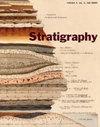寒武纪鲕粒成因及其与海平面升降的关系——以内蒙古清水河剖面为例
IF 0.9
3区 地球科学
Q3 GEOLOGY
引用次数: 9
摘要
摘要:内蒙古华北地台西北缘寒武系地层中存在较厚的鲕粒滩状矿床。下部以陆棚相的钙质泥岩为主,中部以深斜坡相至中斜坡相的泥晶灰岩为主,上部以浅斜坡相至粒滩相的鲕粒灰岩为主。陆架相和深斜坡相是相对海平面上升的产物,而鲕粒灰岩则是相对海平面下降的产物。微观上,所研究的流体表现为径向晶体结构和带芯或不带芯的同心层状结构,单晶或新形态流体和高度钻孔流体。卵状体的大小和形态表明微生物的双重机械影响;苗岭期为构造期,芙蓉期为破坏性期。根据这些观察结果,可以推断微生物(主要由蓝藻丝状化石组成)分泌胞外聚合物(EPS),形成多种细菌生物膜微生物垫。随后通过硫酸盐还原细菌对EPS进行的衰变很可能导致这些液体周围的降水。占据地层上部的鲕粒沉积样式及其可能的微生物成因为区域对比提供了线索,同时也肯定了鲕粒形成的生物控制作用。本文章由计算机程序翻译,如有差异,请以英文原文为准。
Cambrian ooids, their genesis and relationship to sea-level rise and fall: A case study of the Qingshuihe section, Inner Mongolia, China
ABSTRACT: TheCambrian strata at the northwestern margin of the North China Platform in InnerMongolia hold thick oolitic-grain bank deposits.Generally, the strata are dominated by calcareous mudstone of shelf facies in the lower part, micritic limestone consisting of deep to middle ramp facies in the middle part, and oolitic limestone encompassing shallow ramp to grain bank facies in the upper part of each formation. The shelf and deep ramp facies are the result of relative sea-level rise, while oolitic limestones developed in response to relative sea-level fall. Microscopically, the studied ooids are represented by radial crystal structures and concentric laminations with or without cores, single crystal or neomorphosed ooids, and highly bored ooids. The size andmorphology of the ooids indicate a two-fold mechanical influence of microbes; constructive in the Miaolingian and destructive in the Furongian ooids. Based on these observations, it can be inferred that microbes (predominantly composed of filamentous fossils of cyanobacteria) excreted extracellular polymeric substances (EPS) to develop multiple bacterial biofilms microbial mats. The subsequent decay of the EPS through sulfate reducing bacteria most likely caused precipitation around these ooids. The depositional style of ooids occupying the upper parts of the formations, and their possible genesis from microbes provide clue for regional correlation, as well as affirm biological control in the formation of ooids.
求助全文
通过发布文献求助,成功后即可免费获取论文全文。
去求助
来源期刊

Stratigraphy
地学-地质学
CiteScore
1.80
自引率
6.70%
发文量
0
审稿时长
>12 weeks
期刊介绍:
The journal’s mission is to publish peer-reviewed papers that use modern stratigraphic tools – biostratigraphy, chemostratigraphy, magnetostratigraphy, cyclostratigraphy, sequence stratigraphy, climatostratigraphy, lithostratigraphy, GSSPs and more – to explore broad ideas in earth history.
 求助内容:
求助内容: 应助结果提醒方式:
应助结果提醒方式:


